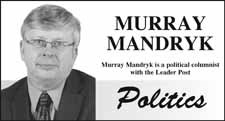If you live on the east side of Saskatchewan, you might just feel a little under-represented.
In the wake of Premier Brad Wall's recent shuffle, the new cabinet table is decidedly tilted to the west. Of the 13 seats west of Saskatoon, eight have cabinet ministers:
Lloydminster, Tim McMillan as Minister of Rural and Remote Health.
Meadow Lake, Jeremy Harrison as Associate Minister of the Economy.
Rosthern-Shellbrook, Scott Moe as Environment and SaskWater Minister.
Martensville, Nancy Heppner as Highways Minister.
Kindersley, Bill Boyd Minister of the Economy and Energy.
Rosetown-Elrose, Jim Reiter as Minister of Government Relations and First Nations and Metis Relations.
Swift Current, Brad Wall, Premier.
Thunder Creek, Lyle Stewart, Agriculture.
Only five west-side ridings do not have ministerial representation right now: Cut Knife-Turtleford; The Battlefords; Bigger (which had Randy Weekes as Rural and Remote Health Minister until last week); Cypress Hills (represented by former minister Wayne Elhard who is still a legislative secretary to the Minister of Intergovernmental Affairs responsible for International and Diplomatic Engagement), and Wood River, (represented by former minister Yogi Huyghebaert).
Of the remaining 16 rural seats only four now have ministers: Humboldt, where Donna Harpauer is now Social Services Minister; Canora-Pelly, where Ken Krawetz remains in Finance; Weyburn-Big Muddy, where Dustin Duncan remains in Health, and; Indian Head-Milestone, where Don McMorris has become the new Crown Investment Corp. and Saskatchewan Liquor and Gaming Authority Minister overseeing both the government's lean and privatization initiatives.
For starters, rural Saskatchewan's 39 seats account for two-thirds of Wall's 18-member cabinet. From 1999 to 2007 under the NDP, there were only one to three rural members in cabinet.
Many argue that many of the issues impacting rural Saskatchewan like highways and agriculture are pretty much transferable from one part of the province to the other. With the possible exception of moving the clocks an hour ahead each spring to benefit from Daylight Savings Time, there aren't that many issues that divide Saskatchewan between east and west.
The four rural ministers on the east or central part of the province all have pretty big portfolios. Also, cabinet has pretty much been tilted to the West/Alberta side since the Wall government came in, anyway. Although it should be noted that the gradual loss from cabinet of Rod Gantefoer (Melfort), Dan D'Autremont (Cannington, who now is Speaker) Bob Bjornerud (Melville-Saltcoats) and now June Draude (Kelvington-Wadena) has made this imbalance that much greater.
If we are to believe what we hear from the Wall government, decisions on economic growth or spending are based more on need. It's also hard to argue that east Saskatchewan ridings of Yorkton, Estevan or Moosomin have suffered, economically, because of a lack of cabinet representations.
Finally, with 12 of the 18 ministers coming from rural Saskatchewan, one might argue that they are doing substantially better than the cities anyway.
Saskatoon with close to a quarter of the province's population only has three ministers (Don Morgan, Gord Wyant and new addition Jennifer Campeau) after the last shuffle saw both Rob Norris and Ken Cheveldayoff dropped.
That is the same as Regina that only has three ministers with the addition of Mark Docherty to Kevin Doherty and Christine Tell.
Meanwhile, both Moose Jaw and Prince Albert remain without cabinet representation. But it's also here where Wall may be starting to get into some trouble.
For example, the burning issue of a second bridge over the North Saskatchewan River in Prince Albert came up again last week with the announcement of not one but two bridge projects in Saskatoon aided by both provincial and federal dollars.
When voters of a particular region become frustrated by such inaction, it's hard not to notice that there isn't a cabinet minister anywhere in sight.
But that's not a problem in you live in Western Saskatchewan.
Murray Mandryk has been covering provincial politics for over 22 years.




